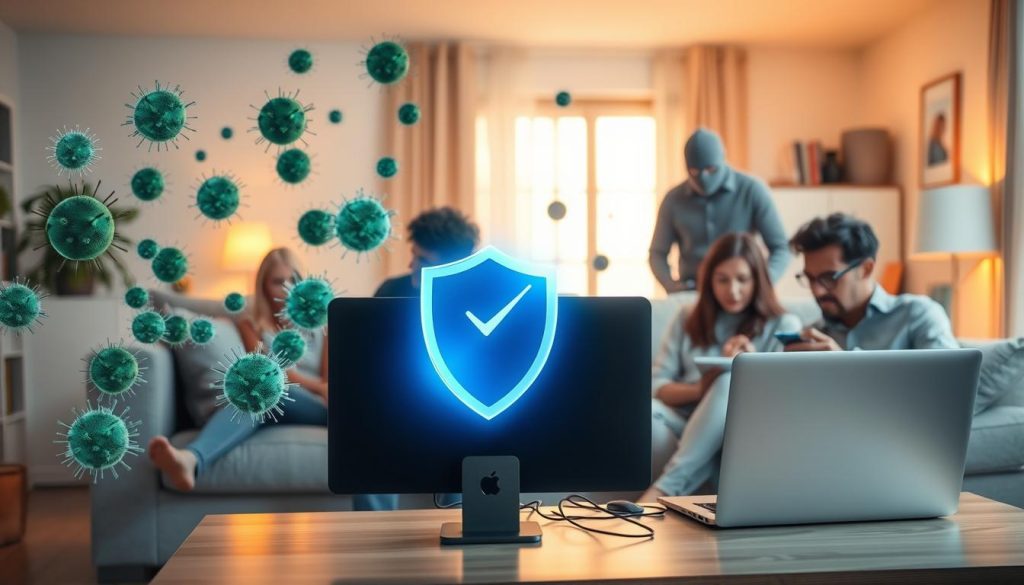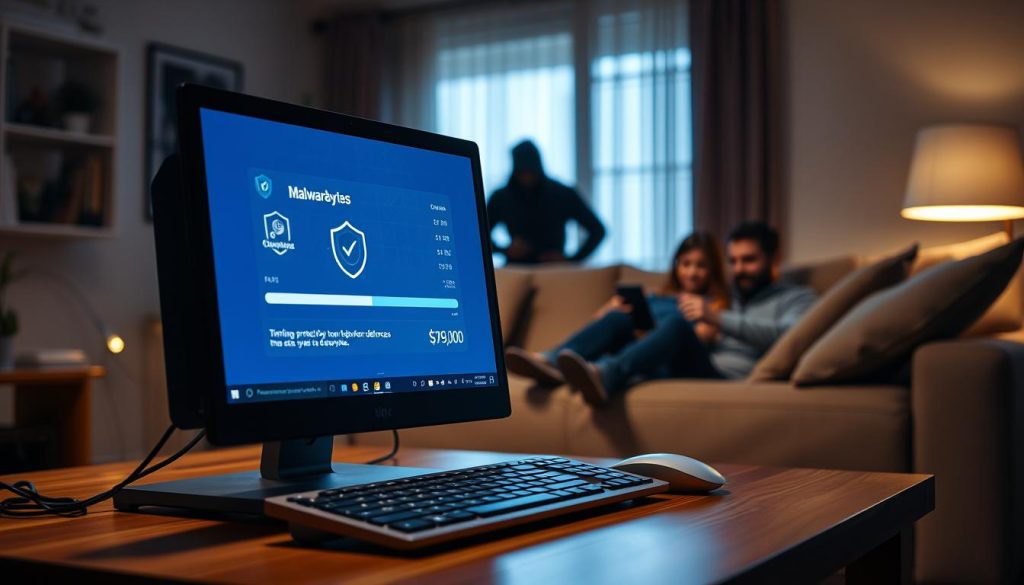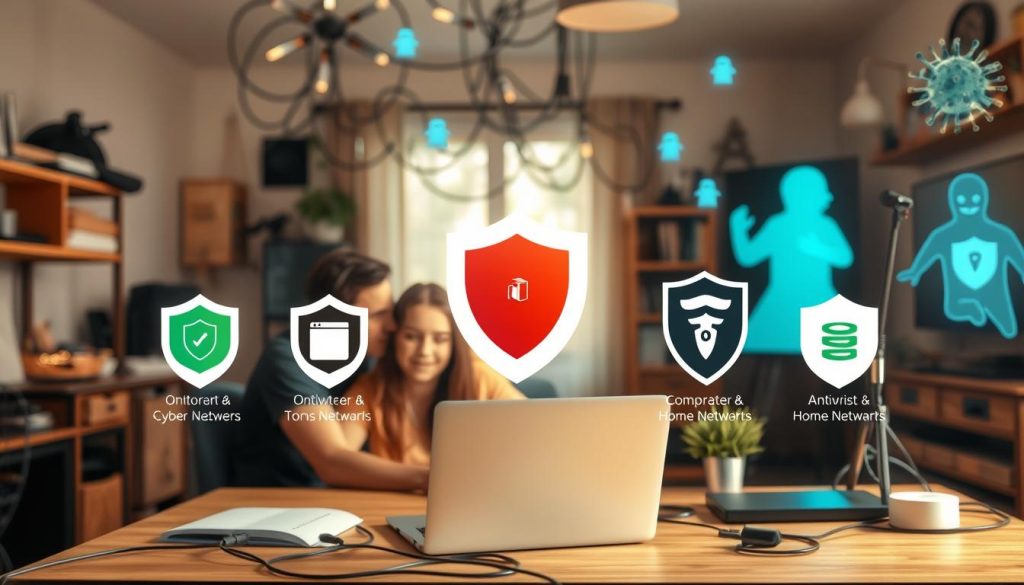Your home network deserves clear, practical guidance. This review cuts through marketing and focuses on real-world protection across Windows, macOS, Android, and iOS devices. You’ll see lab-backed scores and hands-on test notes that highlight scan speed, system impact, and ransomware defenses.
Top names like Bitdefender, Norton, Malwarebytes, and McAfee appear often because independent labs such as AV-Test, AV-Comparatives, and MRG-Effitas report strong aggregate results for these programs. We also note alternatives like Sophos, ESET, Kaspersky, and Trend Micro to show different mixes of firewalls, secure browsers, parental controls, and VPN bundles.
Read on for concise summaries, clear feature comparisons, and pricing context so you can choose protection that fits your family’s needs. Visit HomePrivacyNetwork.com and our YouTube channel for reviews, how-tos, and rule-of-thumb tips to keep your data and devices safe.
Why You’re Here: Choosing Home Antivirus in the present
You need clear, practical guidance to match protection to how you live online today. Modern threats target more than classic viruses; Trojans, ransomware, spyware, phishing, and exploit-based attacks all matter.
Look for multi-layer defenses that combine real-time monitoring, web filtering, and exploit mitigation. These features reduce risk without forcing frequent manual scans or constant intervention.
Independent labs such as AV-Test and AV-Comparatives run regular tests that show how programs perform on detection and system impact. Use those scores as a starting point, then weigh hands-on factors like scan speed and background load.
- Choose protection that updates automatically and covers multiple devices with consistent settings.
- Prioritize strong defaults: real-time shields, scheduled scans, and reliable remediation tools.
- Balance features and bloat—pick software you will actually use, not a long checklist you ignore.
HomePrivacyNetwork.com helps you translate lab data into practical choices. Visit our YouTube channel and blog for step-by-step guides, so your family’s devices stay secure with minimal hassle.
Quick Verdict: Our Top Tested Picks for Home Users
Below is a concise shortlist of our top-tested picks, matched to common priorities: scan speed, ransomware resilience, and useful extras. Use this as a short guide to map strengths to your devices and habits.
- Bitdefender Antivirus Plus — consistent near-perfect lab scores, multilayer ransomware protection, and a hardened banking browser.
- Norton AntiVirus Plus / Norton 360 — suite-level features: intelligent firewall, Data Protector anti-ransomware, backup, and a password manager.
- Malwarebytes Premium — very fast full scans and behavior-based blocking that shines on emerging threats.
- Sophos Home Premium, McAfee AntiVirus, Webroot — solid budget or single-PC options with value, lab backing, or a very light footprint.
Keep an eye on independent scores to confirm each pick’s ongoing performance. Match the program to your devices, and prioritize the features you will actually use.
| Pick | Strength | Ideal if you want | Notes |
|---|---|---|---|
| Bitdefender Antivirus Plus | High detection, ransomware layers | Balanced protection and browser hardening | Top lab scores; strong suite features |
| Norton AntiVirus Plus / Norton 360 | Comprehensive features | Firewall, backup, password manager | Great hands-on and lab results |
| Malwarebytes Premium | Scan speed, behavior blocking | Fast scans and low fuss remediation | Excellent behavioral detection |
| Sophos / McAfee / Webroot | Value, single-PC focus, light footprint | Budget options or older systems | Good lab backing or minimal impact |
best antivirus software for home use: How to Decide What You Need
Start with a device count and a clear view of online habits to match protection to real risks.
Inventory your devices: note the number and types—Windows PCs, macOS laptops, Android phones, iPhones and tablets. Many leading vendors offer cross-platform coverage, but some features vary by platform.
Devices, platforms, and number of users
Decide whether a multi-device bundle or per-device pricing saves money as you add gadgets. Check that key features (web filtering, webcam shields, parental controls) are present on your target platforms.
Risk profile: kids, banking, shopping, work-from-home
If you have kids, prioritize parental controls and content filtering. For banking and shopping, choose hardened browsers and strong anti-phishing protection.
Must-have features vs nice-to-haves
- Must-have: real-time protection, URL filtering, ransomware mitigation.
- Nice-to-have: VPN, password manager, cloud backup.
- Also check management consoles, renewal pricing, and vendor support to keep protection consistent across your household.
| Decision Area | Key Question | What to Watch |
|---|---|---|
| Devices & Licenses | How many and which OS? | Multi-device bundles vs per-device pricing |
| Risk Profile | Who browses and what do they do? | Parental controls, secure browser, anti-phishing |
| Features | Which protections matter most? | Real-time shields, ransomware layers, performance impact |
Bitdefender Antivirus Plus: Best Overall Protection and Value
For households that need reliable detection without a heavy footprint, Bitdefender strikes a solid balance of protection and speed.

Lab performance and multi-layer defenses
Bitdefender consistently earns near-perfect scores across independent labs. It blends signature, cloud, and behavior-based detection to block known and emerging threats.
Ransomware and banking safeguards
The suite includes multi-layered ransomware protection, with behavior monitoring and Ransomware Remediation to restore files if encryption starts.
A hardened browser isolates banking and shopping sessions to reduce phishing and web-based exploits.
- Strong anti-phishing and malicious URL blocking with very high real-world detection.
- Vulnerability scanning, tracker blocking, and automation (Autopilot) to simplify upkeep.
- Cross-platform coverage: Windows and macOS desktops plus optional mobile protection for your devices.
| Item | What you get | Notes |
|---|---|---|
| Lab scores | Near-perfect detection | Consistent across AV-Test and AV-Comparatives |
| Ransomware tools | Behavioral monitoring + remediation | Stops attacks and can recover files |
| Extras | Hardened browser, vulnerability scan | VPN and full password manager require add-ons |
| Pricing (U.S.) | ≈ $49.99 (1 device) / $69.99 (3 devices) first year | Promotional rates; budget for VPN if needed |
In short, pick Bitdefender if you want top-tier security with minimal fuss: quick scan times, light system impact, and features that protect everyday browsing and banking.
Norton AntiVirus Plus and Norton 360: Suite-Level Features for Home Security
Norton combines strong independent lab scores with practical tools that simplify protection across devices. Tests report roughly 97% malware detection and 99% phishing detection, results that hold up in hands-on reviews.
Data Protector locks designated folders to stop unauthorized encryption and provides a reliable layer of ransomware protection. You should mark critical folders, including cloud-synced directories, so your most important data stays safe.
The suite adds an intelligent firewall, exploit shields, a software updater, cloud backup, system tune-up tools, and a built-in password manager. Norton 360 tiers also bundle a VPN and multi-device plans that cover Windows, macOS, Android, and iOS.
- You’ll get consistent lab scores and solid hands-on results against phishing and downloads.
- Shared tools cut the need for separate subscriptions (backup, password manager, tune-up).
- Configure protected folders and run an initial scan after install to confirm coverage.
| Edition | Key features | Ideal if you want |
|---|---|---|
| Norton AntiVirus Plus | Core antivirus, password manager, firewall | Single-device protection with essential tools |
| Norton 360 Standard | Cloud backup, password manager, VPN (limited) | All-in-one protection for one device |
| Norton 360 Deluxe | Multi-device plans, parental controls, more backup | Households with mixed devices and extra storage needs |
Malwarebytes Premium: Fast Scans with Strong Behavioral Defenses
Malwarebytes Premium is built around very fast full-system scans and behavior-based blocking that catches modern threats without heavy CPU drag.
Hands-on testing rates its malware blocking at about 9.9/10, and behavior detection stopped all ransomware samples in stress tests even when real-time components were turned off.
The program adds exploit protection and dark-web breach checks for email accounts. You’ll also find Windows tools for startup app management and a simple control for the Windows Firewall.

Where it excels and where it’s lean
- Speed: very quick scans with low system impact.
- Behavioral defenses: strong real‑time and offline detection of ransomware and new malware.
- Windows extras: exploit shields, startup manager, and firewall controls (some tools require Windows 11).
- Per-device pricing keeps costs clear and lets you scale without wasted licenses.
Note that lab participation varies by period; review current tests and scores alongside hands-on results to confirm the program fits your security needs.
McAfee AntiVirus: A Solid Pick for Single-PC Households
If you protect a single Windows PC and want a familiar brand, McAfee’s slimmed-down offering is worth a close look.
What you get today and where it fits: McAfee focuses on a single-license plan for one primary computer. Independent lab results remain strong, and hands-on tests show excellent phishing and URL defenses.
Core protection and useful extras: the program bundles a basic firewall, WebAdvisor to flag risky links, cleanup tools to remove traces, a File Shredder for permanent deletion, and cryptojacking prevention.
- You’ll like this if you need straightforward antivirus and solid web protection on one Windows machine.
- Phishing and malicious-URL blocking are strong, cutting common malware entry points.
- Note the ransomware tests: one encrypting sample and a wiper-style attack slipped past all layers, so pair the product with backups and folder protections.
| Item | What it offers | Notes |
|---|---|---|
| License | Single Windows PC | Good for lone computer households |
| Extras | Firewall, WebAdvisor, File Shredder | Privacy cleanup and cryptojacking prevention |
| Limitations | Ransomware gap, no unlimited devices | Upgrade to McAfee+ for multi-device coverage |
Bottom line: McAfee AntiVirus is a practical, focused program if you want low-friction setup and reliable web defenses on one PC. Pair it with good patching, backups, and safe browsing to reduce risk further.
Other Notable Antivirus Programs to Consider
Explore these alternatives when you need specific strengths like banking protection, parental controls, or a very light footprint.

Avast One offers a generous free antivirus tier with real-time shields and basic ransomware protection. You can scale to paid plans that add a secure browser and a built-in vpn. If you want a friendly interface and a clear upgrade path, avast one is a practical start.
Kaspersky stands out for deep features: firewall, secure browser, ad blocker, file shredder, parental controls with GPS, backup, password manager, and vpn. Choose it if you value configurability and layered protection.
Trend Micro focuses on banking safety via Pay Guard, social media shields, and parental controls. Its secure browser approach suits users who prioritize safer financial sessions.
- Webroot: tiny footprint and speed.
- Sophos: strong value for families.
- G Data: extensive tools, more complex setup.
- ESET & AVG: clean interfaces; lab results vary.
| Vendor | Key strength | Notable feature | Ideal if you want |
|---|---|---|---|
| Avast One | Generous free tier | Secure browser + vpn option | Easy upgrade path from free antivirus |
| Kaspersky | Feature depth | Firewall, file shredder, password manager | Configurable tools and backups |
| Trend Micro | Banking protections | Pay Guard secure browser | Safer online banking and parental controls |
| Webroot / Sophos / ESET / AVG / G Data | Varied: speed, value, usability | Lightweight or advanced toolsets | Match to speed, interface, or complexity needs |
Core Features That Matter for Home Users
Focus on the defenses that stop attacks before they reach your devices. Leading products combine signature and behavior engines with web filters to block phishing and malware-hosting URLs. You should favor suites that blend prevention with quick recovery tools.
Real-time protection, phishing and malicious URL blocking
Real-time protection inspects files and processes as they run and filters web traffic to stop phishing sites before downloads start. Look for strong URL filtering and anti-phishing engines that act at the browser level.
Ransomware protection and file recovery layers
Ransomware protection should layer behavior monitoring, protected folders (like Norton Data Protector), and rollback or remediation (like Bitdefender’s remediation). These tools help restore files if encryption begins.
Firewall, VPN, and password manager integration
An intelligent firewall reduces prompts and blocks suspicious outbound traffic to shrink windows for data theft or callbacks. A bundled vpn is useful on public Wi‑Fi, and an integrated password manager reduces credential reuse across sites.
- Prefer suites that auto-patch apps and the OS to close common attack vectors.
- Check cross-platform parity; mobile and macOS features often differ from Windows.
- Pick tools with clear dashboards so you can view quarantine items and suggested actions quickly.
Ransomware Protection: What Our Sources and Tests Indicate
Ransomware keeps evolving, so defenders combine detection, containment, and recovery to stay ahead.
Behavior-based detection vs protected folders vs remediation
Behavior-based detection watches for suspicious encryption activity and can kill an attack before wide damage occurs. Protected folders block unauthorized writes to chosen locations. Remediation tools restore files that began to encrypt.
What our testing shows
Bitdefender pairs live behavioral monitoring with Ransomware Remediation. That combo catches encryption actions and restores affected files.
Norton’s Data Protector prevents unauthorized changes inside marked folders. It stops most real-world samples when you include all critical directories.
Malwarebytes’ behavior engine detected every ransomware specimen in hands-on tests and terminated attacks with only minor, unimportant files lost.
- Combine layers: behavior detection, folder shields, and regular backups.
- Configure protected folders to include documents, photos, and cloud-sync paths.
- Keep systems patched and practice phishing awareness to reduce attack vectors.
| Vendor | Primary tool | Practical note |
|---|---|---|
| Bitdefender | Behavioral monitoring + remediation | Restores files after partial encryption |
| Norton | Data Protector (protected folders) | Effective if all critical folders are included |
| Malwarebytes | Behavior-based engine | Quick termination; minimal collateral file loss |
Free Antivirus vs Paid: When Free Is Enough and When It’s Not
Deciding between free and paid protection comes down to risk, device count, and the extras you actually use.
Free antivirus programs like Avast now include real‑time shields and basic ransomware guards with decent lab scores. That makes them a practical option if you browse carefully, keep backups, and run a single device.
Paid editions add quieter operation, stronger remediation tools, priority support, and bundled privacy extras such as a vpn and a password manager. Independent lab reports tend to favor paid tiers for consistent detection, lower false positives, and fewer interruptions.
- You can rely on a free program for basic, real‑time protection if your risk is low and you patch regularly.
- Upgrade when you want family controls, reliable ransomware recovery, and one‑stop web protection across many devices.
- Expect free versions to show prompts, ads, or limited cleanup tools; paid tiers usually reduce prompts and add centralized management.
| Scenario | Recommendation | Why |
|---|---|---|
| Single low-risk user | Free edition | Good real‑time shields; saves money |
| Multi-device family | Paid suite | Parental controls, centralized settings |
| Frequent banking or sensitive data | Paid suite | Stronger remediation, secure browsers |
Keep a free scanner as a second opinion even if you buy a paid plan. Base your choice on how much time you want to spend on alerts, and on the sensitivity of your data.
Performance Impact and Scan Speed
How fast scans run and how light an app feels on your PC directly affect daily security. You want protection that works without interrupting work, gaming, or streaming. Below we cover full-system and quick scans, and which vendors shine on speed and low resource use.

Full-system scans, quick scans, and system slowdowns
Full scans can take longer on first runs while the app builds caches and baselines. After that, subsequent scans usually finish faster and with less impact.
Quick scans provide interim assurance between deep checks. Schedule deep scans for idle hours or enable gamer/do-not-disturb modes to defer heavy tasks.
Vendors noted for speed and lightweight footprint
Malwarebytes earns praise for speedy full scans. Webroot is known for a tiny footprint and fast operation. Some products, like Avast, may slow certain PCs during deep scans in our tests.
- Compare how long a full scan takes and whether quick scans are adequate.
- Look for smart scheduling and low-background load on Windows laptops.
- Test trials on your system to see real results before committing.
| Vendor | Strength | Practical note |
|---|---|---|
| Malwarebytes | Fast scans | Good balance of speed and detection |
| Webroot | Light footprint | Minimal resource use on older machines |
| Avast | Feature-rich | May impact performance during deep scans |
Pricing, Licenses, and Value for Families
How vendors price licenses often determines whether your family is fully covered. Look at counts, renewal rates, and included extras to match protection to your household needs.
Single-device vs multi-device bundles
Single-device plans suit one user or a lone Windows laptop. McAfee now targets a single Windows PC license in its basic plan.
Multi-device bundles cover several devices and usually add tools like a vpn or a password manager. Norton 360 offers multi-device packs that include backup and a password manager. Bitdefender often lists first-year discounts (≈ $49.99 for one device, $69.99 for three).
Transparent pricing models
Per-device pricing can avoid wasted seats. Malwarebytes uses clear per-device tiers (examples start around $44.99 for one and scale up to 20 devices).
- Compare single licenses vs bundles to avoid overbuying.
- Factor intro discounts against renewal rates and auto‑renew terms.
- Verify platform coverage so your macOS, Android, iOS, and windows devices are included.
- Assess total cost of ownership over 2–3 years, not just year one.
| Plan | Typical scope | Good if you want |
|---|---|---|
| Single-device | One PC | Low cost for one user |
| Multi-device bundle | 3–10 devices | Family management + extras |
| Per-device pricing | Flexible count | Scale without wasted licenses |
Windows, macOS, Android, and iOS: Picking the Right Coverage
Verify parity across platforms so core protections don’t disappear when you switch devices. Leading vendors like Bitdefender and Norton support Windows, macOS, Android, and iOS, but feature sets often vary.
Cross-platform protection and app quality
Check which features differ by platform. Secure browsers, firewall controls, webcam shields, and parental controls are often richer on Windows than on macOS or mobile.
Look for mobile apps that add anti-phishing, web protection, VPN access, and permissions monitoring. Ensure the iOS and Android app links to the desktop console or account so you can manage family status in one place.
- Password sync: confirm the password manager syncs securely across browsers and devices.
- Usability: choose apps with clear alerts and simple navigation on smaller screens.
- Updates: prefer vendors that roll out timely patches and platform feature parity.
| Platform | Common feature gaps | Practical note |
|---|---|---|
| Windows | Full firewall, hardened browser | Best support for banking protections |
| macOS | Limited webcam/parental tools | Verify banking protection availability |
| Android / iOS | Varying web shields, VPN quality | Test app UX and permissions monitoring |
Tip: check license terms so your plan covers the exact mix of operating systems in your household without surprises.
How We Compare Antivirus Programs
We combine repeatable lab data with live testing to show how products behave against everyday threats. This method blends broad metrics with hands-on verification so you can judge real-world value.
Independent lab scores, hands-on tests, features, and support
We weight independent scores from AV‑Test, AV‑Comparatives, and MRG‑Effitas to capture long-term detection and performance trends. Those numbers give an objective baseline across many samples and time periods.
Our hands-on testing complements lab data. We run live malware samples, phishing pages, and malicious URL checks to record practical results. That shows how tools react under current attack methods.
- Detection and performance: lab scores provide repeatable measurements across many samples.
- Real-world handling: hands-on tests reveal how a program blocks phishing and malicious URLs today.
- Usability: we measure scan speed and system impact so protection doesn’t slow your daily work.
- Ransomware: we test behavior detection, protected folders, and remediation/rollback effectiveness.
- Suite features: we review the firewall’s intelligence, password manager quality, VPN reliability, backup tools, parental controls, and privacy extras.
- Platform parity: we check app quality across Windows, macOS, Android, and iOS to confirm consistent protection.
- Value and support: pricing, renewal terms, device counts, and vendor responsiveness influence our final scoring.
| Aspect | What we measure | Why it matters |
|---|---|---|
| Lab scores | Detection & performance | Repeatable, broad-sample assurance |
| Hands-on tests | Malware, phishing, URLs | Real-world behavior & current protection |
| Features | Ransomware, firewall, VPN | Practical value beyond detection |
Our goal is transparent criteria you can follow. When labs and live results align, you get confidence in long-term protection and clearer guidance to pick the right program for your devices.
Stay Protected with HomePrivacyNetwork.com
Keep your digital life secure with clear steps, video walkthroughs, and timely product updates. HomePrivacyNetwork.com is dedicated to helping you protect your home, business, or personal devices wherever you connect to the internet.
Watch our YouTube channel for internet security videos
You’ll find short, practical demos that show how to configure protection, run scans, and enable key features like ransomware defenses and secure browsers.
Our videos walk through settings step-by-step so you can replicate them on your own devices quickly.
Check our blog for new reviews, how-tos, and product updates
Our blog publishes ongoing product updates and how-to tutorials on secure browsing, password hygiene, and multi-device management.
We synthesize lab results and hands-on testing so you get balanced review content that highlights detection, performance, and key features.
- Guides to set up password managers and two-factor authentication.
- Router hardening, parental control strategies, and backup checklists.
- Alerts on major vulnerabilities and vendor updates that affect your data and devices.
| Resource | What you get | When it helps |
|---|---|---|
| YouTube channel | Step-by-step setup videos and product walkthroughs | When you prefer visual demos and quick fixes |
| Blog articles | In-depth reviews, how-tos, and update summaries | When you need detailed analysis and comparison |
| Alerts & Guides | Patch guidance and recovery checklists | When urgent vulnerabilities or data incidents appear |
Conclusion
This closing summary turns lab data and hands‑on tests into simple next steps for you. You now have a clear shortlist: Bitdefender leads overall, Norton shines at suite features, Malwarebytes offers quick scans and strong behavior defenses, and McAfee fits single‑PC needs.
Weigh protection layers—ransomware shields, phishing filters, web filtering—and match features like a firewall, VPN, and password manager to your daily habits. Choose licensing that aligns with your device count and long‑term costs, not just intro pricing.
Take action: pick a plan, install it across your devices, enable protected folders and secure browsing, and keep apps updated. Visit HomePrivacyNetwork.com and our YouTube channel for setup videos, live tests, and ongoing guidance to keep your network and family secure.

